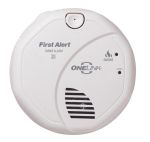 Today, everywhere you spend the night, you can expect the protection of a smoke alarm. Government, insurance and specific industry regulations require smoke alarms to be installed during construction, manufacturing and/or sale, in every type of structure. They are required by all local and state laws in occupied buildings of every type: Single and multiple occupancy dwellings, hospitals, schools, hotels, motels, bed and breakfasts, dormitories, general occupancy, trains, airplanes, buses, RVs, mobile homes, and so on. There is one and only one exception. The recreational boating industry does not install or require smoke alarms for consumers who purchase boats with sleeping quarters
Today, everywhere you spend the night, you can expect the protection of a smoke alarm. Government, insurance and specific industry regulations require smoke alarms to be installed during construction, manufacturing and/or sale, in every type of structure. They are required by all local and state laws in occupied buildings of every type: Single and multiple occupancy dwellings, hospitals, schools, hotels, motels, bed and breakfasts, dormitories, general occupancy, trains, airplanes, buses, RVs, mobile homes, and so on. There is one and only one exception. The recreational boating industry does not install or require smoke alarms for consumers who purchase boats with sleeping quarters
There is a substantial amount of documentation, dating back to the 1960s, demonstrating significant reduction in property loss, injury and deaths as a result of the installation of working smoke alarms. According to the National Fire Protection Association (NFPA), for decades, smoke alarms have proven effective in two important ways: “alerting people to the presence of unwanted fire thus permitting their timely escape…and by providing a mechanism for setting in motion the early extinguishing of fire by the occupants or others”.
BOATING FIRE CAUSES AND PROBLEMS
A pleasure boat contains a number of potential fire dangers, certainly more than we find in a typical home. Aboard a pleasure boat we find a large fire load in the form of flammable or combustible fuel storage, many times supplying multiple devices, an AC electrical system, a DC electrical system, (all of which are regularly subject to moisture, corrosion, vibration and jarring as part of the normal use). The housing industry has taken steps to reduce the combustibility of construction materials that are toxic and volatile when involved in a fire. A boat’s construction materials are extremely combustible and are likely to remain that way for the foreseeable future. Most boat fires start slow in a smoldering state. According to Boat US these fires are of electrical origin 55% of the time. Propulsion problems, fuel, engine and exhaust problems, unattended cooking, careless smoking, heating devices, and other appliances are also among the causes. Further, there is no annual inspection requirement (like many automobile regulations) by a qualified technician who may find and correct problems that may cause a fire.
THREE SPECIFIC MARINE FIRE EVENTS
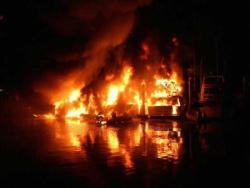 There are three fire events that represent the greatest percentage of marine industry fire losses. The first is a fire that starts aboard a boat in a marina. This fire, usually electrical in origin, starts small and typically smolders for some time. If the fire is not detected, it will continue until the fire gains headway and visibly burns outside the confines of the origin boat. At this point the fire is beyond control by any nearby people or marina personnel. Every year marina fires cause considerable damage to boats and the marina, and create serious environmental issues when boats sink and fuel floats freely to the surface. (Seattle has had 35 serious marina fires in 5 years.) These fires always start aboard a single boat. These same conditions become more dangerous when there are people in the boat and there is no warning of the fire.
There are three fire events that represent the greatest percentage of marine industry fire losses. The first is a fire that starts aboard a boat in a marina. This fire, usually electrical in origin, starts small and typically smolders for some time. If the fire is not detected, it will continue until the fire gains headway and visibly burns outside the confines of the origin boat. At this point the fire is beyond control by any nearby people or marina personnel. Every year marina fires cause considerable damage to boats and the marina, and create serious environmental issues when boats sink and fuel floats freely to the surface. (Seattle has had 35 serious marina fires in 5 years.) These fires always start aboard a single boat. These same conditions become more dangerous when there are people in the boat and there is no warning of the fire.
The second type of fire event occurs while the boat is underway and out on the open water. According to the Coast Guard, nearly 90% of these fires start in the engine room in the propulsion or related equipment. Many times these fires burn undetected while the crew is on the bridge and unaware of the problem. The fire is eventually discovered but most often well beyond the intercession of the crew. The occupants are forced to flee the vessel, most times into the water. The third is a gasoline vapor event in which a fire or explosion occurs very rapidly when vapors (heavier than air) accumulate in the bilge of boat and come in contact with an ignition source. The result most times is a volatile explosion resulting in injuries, death and damage. These events typically take place during or immediately after fueling the boat. These vapor events also take place during maintenance, usually by unskilled technicians. Fume detection has been available for many years but is typically not installed or required.
DIFFICULT AND COMPROMISED EGRESS – COMPOUNDS THE FIRE PROBLEM
There are unique egress challenges from a fire that face the occupants of a boat in the above mentioned fire events.
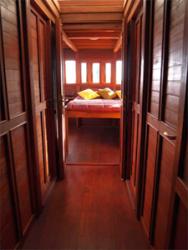 First is the design of the boat. The rule states (both NFPA 302 and ABYC H-3) that the boat must have a second means of egress that is not blocked by an engine room or galley. The rule is satisfied by one 14″ x 18″ hatch in the forward part of the boat.
First is the design of the boat. The rule states (both NFPA 302 and ABYC H-3) that the boat must have a second means of egress that is not blocked by an engine room or galley. The rule is satisfied by one 14″ x 18″ hatch in the forward part of the boat.
Many boats, particularly over 40 feet, have staterooms with no second means of egress. The only way to exit the stateroom is to enter back into the common area in the boat. The new full beam master most times is also a one way out stateroom. The port and starboard windows that are sometimes installed in the hull are not large enough to be effective or considered as egress. The forward stateroom usually does have a properly sized hatch as long as it can be reached and opened and it has not been covered by a rigid inflatable boat.
It is difficult to provide two ways out of every stateroom without compromising the water keeping integrity of the boat. We cannot install an 18″ hatch in every stateroom but we should be mindful of these serious stateroom egress limitations when a fire occurs in or near the common area.
Case in point: On March 31st of last year, a fire occurred in a 76 foot Lazzara, with seven people aboard during a stop at the Miami Beach Marina. The official cause was undetermined but interviews indicate careless smoking at about 1AM may have started the fire aboard the boat. Nearly four hours later the occupants were awaken by the sound of the fire ravaging the upper part of the boat. Five of the seven escaped with burns, cuts and fractures. Two were trapped in a port stateroom with only a small porthole, barely large enough to wave an arm. They could not enter the common area, which was now involved in fire. Fortunately, the two remaining victims were cut from the hull of the boat, by fire department personnel, shortly before fire consumed the boat and it sank.
Compromised egress was obviously a life threatening factor at this fire event. But the true injustice here was the lack of any type of inexpensive early warning device aboard the $5,000,000 Lazzara where people were sleeping.
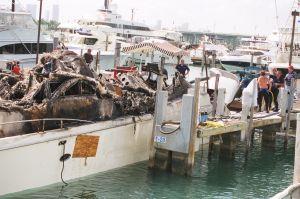 The second egress concern takes place when the boat is away from the dock. There is no place to run from a fire while underway. As stated earlier, 90% of the fires that occur on the open water start in the engine room. In vessels over 40 feet the occupants may be two levels above the engine room and have no way of knowing about a fire there.
The second egress concern takes place when the boat is away from the dock. There is no place to run from a fire while underway. As stated earlier, 90% of the fires that occur on the open water start in the engine room. In vessels over 40 feet the occupants may be two levels above the engine room and have no way of knowing about a fire there.
Engine room fires typically burn undetected for some time. In an unacceptable number of cases, the fixed fire extinguishing system fails to activate in a timely fashion or at all. Many fixed systems are installed too close to natural and/or mechanical ventilation equipment (see picture at left of extinguisher right beside blower), too low in the engine room to effectively meet the trip temperature, or too remote in the engine room for effective application of the extinguishing agent.
Case in point: On February 22 of last year a 56 foot Sunseeker departed Fort Lauderdale enroute to the Keys. Two miles off Elliot Key the owner noticed smoke coming from the engine room. Upon investigation, he discovered an engine room fire that was beyond extinguishment by those aboard the boat. The engine room extinguishing system failed to activate – automatically or manually. The four aboard evacuated the boat into the water and had to be rescued. The boat was a total loss.
Early warning detection should be installed in the engine rooms of vessels over 40 feet. The devices should alarm on the bridge. Fixed fire detection should also be properly installed in the engine room and boat builders should be mindful that the proper installation of fixed fire extinguishing equipment is critical if the system is to activate on a timely basis. Most times an improper installation or maintenance is the reason fixed systems do not function properly.
 Early warning detection is critical in circumstances such as these but despite the smoke alarm’s safety benefits, obvious track record, inexpensive cost, and public acceptance, we don’t employ smoke alarms in the boating industry. It is very important to note that statistics show when a smoke alarm is activated, the fire is extinguished by the occupants over 80% of the time. Most fires, discovered in the early stages can be easily handled.
Early warning detection is critical in circumstances such as these but despite the smoke alarm’s safety benefits, obvious track record, inexpensive cost, and public acceptance, we don’t employ smoke alarms in the boating industry. It is very important to note that statistics show when a smoke alarm is activated, the fire is extinguished by the occupants over 80% of the time. Most fires, discovered in the early stages can be easily handled.
In the gasoline vapor fire events a smoke alarm would be of little value. However, engine room fume detection is available and should be used for all gasoline powered vessels. A more robust approach to public education about the dangers of flammable vapors aboard a boat is also suggested.
OPPOSITION TO MARINE EARLY WARNING DETECTION
There has been opposition to a smoke alarm requirement for pleasure boats. Some of the justifications for the opposition include:
- The Coast Guard reports no fire deaths or measurable fire losses.
- A special smoke alarm will have to be designed for marine use.
- Smoke alarms will false alarm when used on a boat.
- The Coast Guard does not require smoke alarms.
- There are no UL marine listed smoke alarms
The responses to theses positions are listed below:
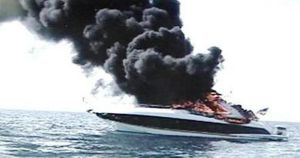 NO FIRE DEATHS OR MEASURABLE FIRE LOSSES
NO FIRE DEATHS OR MEASURABLE FIRE LOSSES
The United States Coast Guard annually publishes the Boating Safety Statistics Report. The most recent report (2009) shows that there were 260 fire incidents nationwide among over 13,000,000 registered vessels. What the Coast Guard does not state is that this information represents primarily only open water fire events that occur away from the marina. Marina fire events and losses are typically not recorded in this data.
FEMA, through the National Fire Incident Reporting System (NFIRS) program and the National Fire Protection Association (NFPA) also attempt to track marine fire loss information. Both agencies acknowledge and report that they can provide only incomplete boating fire loss statistics at best. A number of local fire departments do not use the NFIRS reporting system and in many cases boat fires are recorded as ‘miscellaneous’ on fire reports and cannot be retrieved nationally by category.
Case in point: In 2005, NFIRS reported two fire deaths in sailboats. Random articles were emailed to me on two other 2005 fire deaths in powerboats on the east coast. The 2005 Coast Guard Boating Safety Statistics Report lists zero fire deaths in 2005. The regulatory authority granted to the Coast Guard does not require them to investigate marina fires. Their responsibility in a marina fire event is limited to environmental issues.
We cannot identify or quantify fire losses in the boating industry. Despite this, there have been marine safety concerns who continue to use the incomplete Coast Guard information as a basis for fire safety considerations and justifications – specifically smoke alarms.
SPECIAL MARINE SMOKE ALARMS
In the 1990s, a tax payer funded study was conducted by the Coast Guard, the American Boat and Yacht Council (ABYC) and Underwriters Laboratories (UL) in order to assess the feasibility of smoke alarms aboard pleasure boats. Off the shelf household devices were evaluated. As a result, Underwriters Laboratories published UL Report 92NK26482 – Fire Detection in Recreational Vessels. The report states: “included testing of fire detection devices to shock, vibration, and salt fog corrosion similar to what the devices may be expected to encounter in actual (marine) use”. The UL report also noted favorably that “Some presently (1990s) available (smoke alarm) models successfully completed the marine tests. Thus it is possible that at least some manufacturers may not need to produce special marine use models, thus minimizing the costs to the boat builders and ultimately to the consumers.” Despite these findings, the US Coast Guard, the Underwriters Laboratories and the ABYC did nothing with the information obtained during the study. No requirements, recommendations or advisories were ever brought forward and for many years UL did not have or develop a marine listing for smoke alarms.
SMOKE ALARMS WILL FALSE ALARMS
According to device manufacturers there is no credible current test information (including the above mentioned UL report detail) that supports a false alarming problem. As with every smoke alarm installation there is always a chance that the occupant will disable the alarm or won’t maintain the batteries. The potential of improper use by a small percentage of users is not cause to deny the other responsible boating consumers smoke alarm protection. The boat builder and the boating industry are far more exposed to substantial legal challenges by not providing widely accepted safety devices to the consumer.
THE COAST GUARD REQUIREMENTS
The Coast Guard has for a number of years mandated smoke alarms in small inspected vessels with sleeping quarters. The Coast Guard (CFR 46 Part 181.4 and 181.45) states that “small passenger vessels ..must be fitted with an independent modular smoke detecting and alarm unit..and must meet Ul217 and be listed as a single station smoke detector suitable for use in recreational vehicles”. (The National Fire Protection Association in NFPA 302 Fire Protection Standard for Pleasure and Motorcraft requires the same Ul217 recreational vehicle smoke alarm device in vessels over 26 feet.) The Coast Guard has also recently expanded the requirements for early warning fire detection aboard uninspected commercial fishing (46 CFR Part 28.325) and commercial towing vessels (46 CFR Part 27.203).
The Coast Guard does not have a smoke alarm requirement for uninspected, non commercial, vessels (pleasure boats) and it is unlikely they ever will. The Coast Guard has invested very few resources in its regulatory role within the pleasure boating industry for a number of years. The Coast Guard depends upon the boating industry’s rule making organizations to manage pleasure boat safety regulations and occasionally provides government funding in order to do so.
The Coast Guard does not usually promote pro-active fire protection and has been criticized publicly for its position on early warning detection in the engine room of some small passenger ferries by the National Transportation Safety Board (NTSB). There have been a number of NTSB recommendations that have been disregarded by the Coast Guard dating back to the mid 1980s.
NTSB to the Coast Guard dated October 1, 1985 following a fire aboard fishing vessel Judith Lee Rose:
“..the lack of fire detectors allowed the fire to burn out of control before it was discovered. This is the tenth accident which the Safety Board has investigated in which the lack of fire detectors was a factor which contributed to the loss of an uninspected vessel. Because the earliest possible detection allows the best response to a fire, the Safety Board believes that if the fire detector had been installed in the unmanned engine room, the vessel might have been saved.”
NTSB to the Coast Guard dated March 20, 2007 following a fire aboard the Massachusetts carrying 65 passengers:
“..Contributing to the extent of the damage was the absence of a fixed fire detection and suppression system, which precluded the crew from receiving timely notification of the fire and which allowed the blaze to spread throughout the engine room. The absence of a requirement for a fire detection and suppression system aboard the Massachusetts put the vessel, its passengers, and its crew at greater danger. This accident illustrates why the National Transportation Safety Board has previously made recommendations, following its investigation of other engine room fires, to the Coast Guard for certain vessels to be fitted with fire detection and suppression systems”.
The Coast Guard has not complied with these NTSB recommendations. The NTSB lists the engine room detection recommendations to the Coast Guard as “Closed – Unacceptable Response”.
The Coast Guard maintains a very re-active approach to fire protection. Most of the Coast Guard training, equipment, requirements and emphasis is all about fire fighting – after the fire has occurred.
UL LISTINGS AND MARINE SMOKE ALARMS
In the late 1970s the RV industry recognized the need to protect its customers from the dangers of fire. The RV industry worked with Underwriters Laboratories and developed a UL test for Recreational Vehicles. This test was more stringent than the normal household tests. It included exposure to both higher and lower temperatures and humidity as well as shock and vibration tests. The UL RV test also included a 48 hour salt spray test, a key part of other UL marine tests. Since 1982 the recreational vehicle industry has had a requirement in place for smoke alarms tested to the Underwriters Laboratories UL-217 Smoke Alarm Standard RV testing criteria. Despite the participation in the mid-nineties tax payer funded marine smoke alarm study, Underwriters Laboratories still did not develop a marine smoke alarm listing. The Coast Guard and the NFPA 302 Watercraft committee were left to designate the UL RV testing criteria for their smoke alarm requirements or be without a smoke alarm requirement completely.
Many opposed the use of the RV testing criteria stating “the UL Recreational Vehicle testing was inappropriate for marine use”. But a comparison of the test criteria showed that the UL RV tests were acceptable for marine use and in some cases the UL RV tests were more stringent than the UL marine tests. The test criteria actually appeared to be more appropriate for marine uses than the title suggests. For a number of years Underwriters Laboratories has been effectively holding the marine industry over the terminology barrel. Industry standards writers don’t want to recognize the RV device and won’t move forward with a requirement until UL marine tested product is available. A UL 217 Marine Smoke Alarm test criteria was finally added in 2006. As of this writing no smoke alarm manufacturer has submitted a device to UL for marine testing. The smoke alarm manufacturers cite that testing the same product, using nearly the same UL test criteria for a different listing title is just too expensive. This is a big problem our industry needs to overcome. The marine industry must specify the RV alarms or be without a properly tested smoke alarm for the marine consumer.
Acknowledging the lack of marine product availability, in a recent “Fire Safety Guidance” advisory, the Coast Guard has allowed the installation of non marine use (and RV) devices stating: “Option two is the use of a fire alarm system that is UL listed or FM approved. This is the type of fire alarm system commonly installed in buildings. These systems are not specifically approved for marine use, and are designed to be installed in accordance with the guidance in NFPA 72 and their manufacturer’s design manual.” Today’s smoke alarm manufacturers produce devices for use in many harsh environments. When a device is manufactured it may be installed in a garage in Alaska, a cabana in Central America or a shed on the Outer Banks. Smoke alarm manufacturers feel that their products, when installed and maintained according to the instructions, will function properly in the enclosed spaces of a boat. The above mentioned UL report supports these opinions as many off the shelf, non-marine devices “successfully completed the marine tests” and “some manufacturers may not need to produce special marine use models”.
CARBON MONOXIDE – SOME COMPARISONS
In stark contrast, there are a number of dedicated industry individuals and organizations who have spent many worthwhile hours educating the boating public about the causes, dangers, production and detection of carbon monoxide. The positive industry momentum on this issue is remarkable. We can see the impact this effort has made particularly in the awareness the boating public now has about CO. There are many similarities that apply to fire protection and the consumer could benefit from the help of these same individuals and organizations.
Injuries recorded from fire incidents are far greater than the CO incidents. CO events typically do not have any monetary or environmental losses while fire causes tens of millions of dollars in losses in property and environmental damages annually.
Carbon monoxide has received a lot of attention and CO detection is now required and installed aboard all gas boats with accommodation spaces. Smoke detection is not recognized as necessary. The 2009 USCG Boating Safety Statistics show (fire data is not complete):
| 2009 Carbon Monoxide | 17 events | 39 injuries | 1 death | $0 in losses |
| 2009 Fires | 260 events | 130 injuries | 5 deaths | $12,500,000+ in losses |
Carbon monoxide events usually occur on the open water and it can be expected that these CO statistics are fairly accurate. Many fire losses occur in marinas where the Coast Guard is not the lead investigating agency. It is the author’s opinion that the fires losses in the annual Coast Guard Boating Safety Report are greatly understated.
THE COAST GUARD AND THE ABYC
The Coast Guard has been challenged with a new and important agenda with Homeland Security efforts and is not actively managing the CFRs for pleasure boats. The Coast Guard will not be adding a smoke alarm requirement to the CFRs for pleasure boats.
The ABYC, the boating industry’s primary standards writing organization, does not have a smoke alarm requirement. Although a smoke alarm proposal was written in early 2006, there has been little activity in moving forward with a requirement.
Some industry rule-makers have scrutinized the addition of a smoke alarm requirement and have spent more time on the why nots than the whys. The ABYC participated in the earlier referenced and favorable UL marine smoke alarm study in the mid nineties but took no action on the findings. The ABYC has also paid a consultant who used the incomplete Coast Guard fire loss data in his report to the ABYC Gas Detector committee regarding fire losses vs. the justification for the installation of smoke alarms. No mention of the incomplete nature of the USCG safety statistics was ever made in the study.
ABSENT A BOATING INDUSTRY SMOKE ALARM REQUIREMENT
The boating industry frequently draws comparisons with the RV industry and both compete for the same recreational spending dollars. The RV industry has required smoke alarms for nearly 30 years – since 1982. The smoke alarm is required, by the RVIA and the NFPA (who collaborate to write one RV industry safety standard – NFPA 1192), because it provides an important and expected level of basic consumer safety.
Recently there has been large unprecedented civil awards that the boating industry has been ordered to pay to individuals who were injured in boating accidents. One would think that the boat builders would also be at risk should a fire cause injury or death where a smoke alarm was not installed.
The established precedence of smoke alarm installation, by the builder, in every type of sleeping accommodation found in the United States should be considered. Further, the NFPA 302 smoke alarm requirement for pleasure boats, the Coast Guard requirements for inspected vessels, the new Coast Guard requirements for uninspected commercial vessels, and the long standing RV requirements and history add an additional level of precedence for smoke alarm installation that the boating industry should consider. Civil risk is present should a fire loss occur on a boat where early warning detection may have had a positive impact on the outcome. The public is used to having smoke alarm protection provided for them by the builder and they expect this type of protection when they purchase a boat they will be sleeping in.
The next generation of boaters and their families has entering the boating market place. This safety conscious generation has never spent the night without the inexpensive protection of a smoke alarm while sleeping. The typical boating consumer is spending discretionary money. They consider basic life and property protection to be essential, not discretionary. The lack of an inexpensive smoke alarms doesn’t help sell more boats!
A CAUSE FOR (SMOKE) ALARM
The key components to any successful fire protection program are: fire prevention, detection, egress and suppression. All of these necessary components then need to be supported by solid fire protection standards. Fire protection specialist stress, after prevention, that early detection is most critical to timely intervention and limiting losses caused by fire.
The use of smoke alarms is the single most important addition in the reduction of life, injury and property losses from fires all over the United States during the last century. For over four decades smoke alarms have been required and have successfully contributed to the reduction of losses caused by fire in every kind of structure. It is a proven fact that fires discovered in the early stages by smoke alarms are successfully handled by the occupants, or other nearby persons, before the arrival of fire department units. Fires that are permitted to gain headway typically result in much larger fire losses.
The installation of smoke alarms will have a positive impact for the sleeping occupants aboard a boat. A smoke alarm can also alert marina occupants and employees to a fire in an unoccupied boat before the fire burns beyond the confines of the vessel and damages other property. Engine room smoke detection will alert the captain of a fire while underway and provide him a better opportunity to shut down propulsion and handle the fire before he is forced to leave the vessel and enter the water.
There are a number of industry leaders – individuals, organizations and corporations who have stayed on the sidelines when it comes to improving marine early warning fire detection. It’s time the recreational boating industry discovered smoke alarms and make them part of the standard safety equipment found on a boat.
Written by John McDevitt, SAMS®-SA
Captain John McDevitt is an experienced fire fighter/officer and holds an Associates Degree in Fire Protection. He holds a 100 Ton USCG Masters License since 1992. He is active with SAMS, the ABYC, and the NFPA. He can be reached at jmcdevittcaptain@aol.com or 610-220-5619. Your questions, comments, thoughts and concerns are always welcome.






